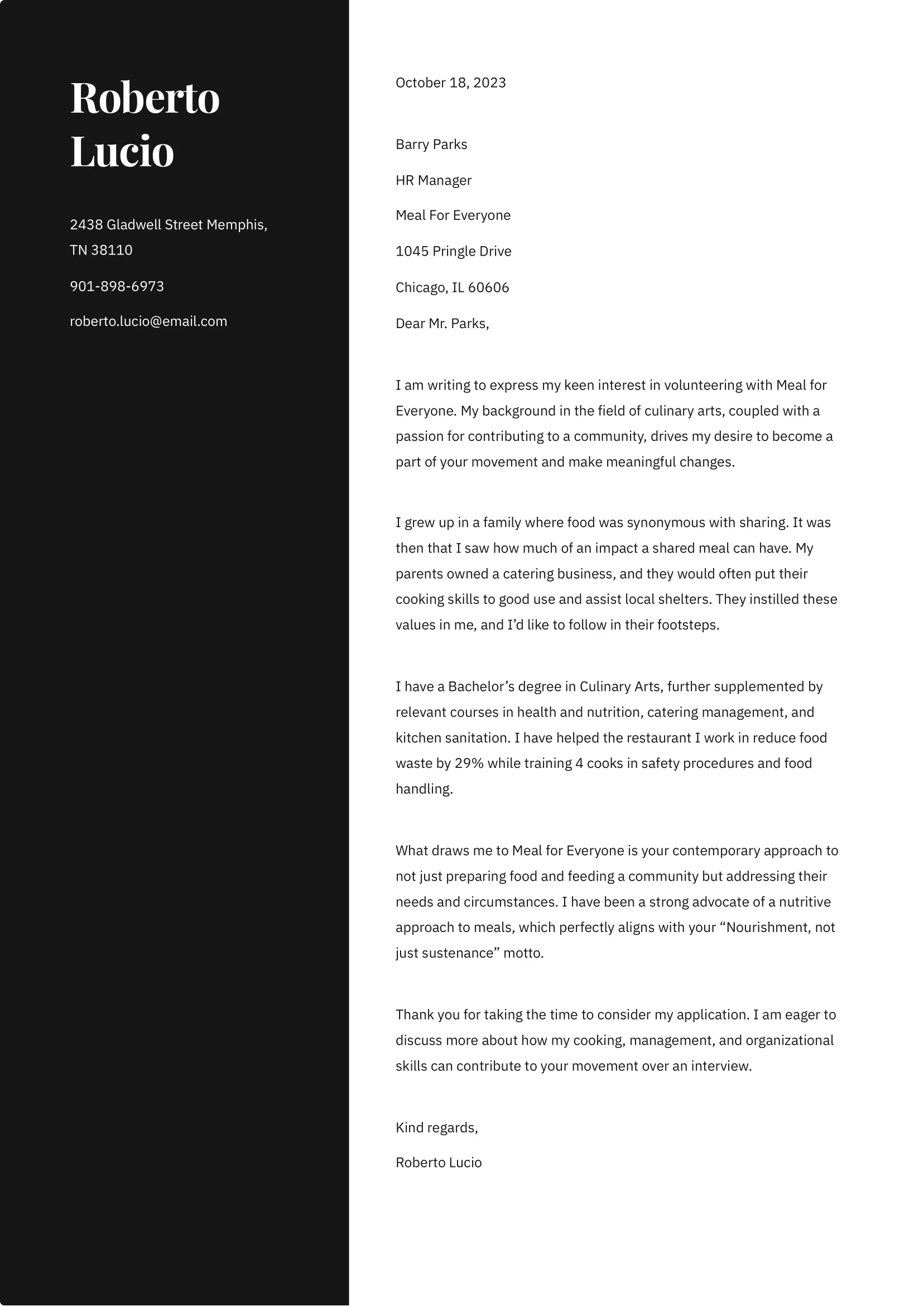Struggling to figure out how to write a motivation letter for a job? You're not alone. A strong motivation letter can set you apart by showcasing your passion, skills, and fit for the role—especially when applying for competitive positions.
In this guide, we’ll walk you through the entire writing process, from structuring your letter to tailoring it for specific job applications.
Key Takeaways
A motivation letter is a one-page document candidates write and submit to highlight their passion for the opportunity.
You can write a motivation letter for a university educational program, internship, non-profit organization, or volunteering movement.
The best way to format a motivation letter is to use a business letter format.
Every motivation letter needs to have a catchy opening, an information-filled body, and a conclusion that features a call to action.
A letter can have three longer paragraphs and feature a storytelling approach or five to seven shorter paragraphs that are more factual.
What Is a Motivation Letter?
A motivation letter is a one-page document written by those who want to express strong interest in certain roles and positions. In some ways, a letter of motivation is similar to a cover letter example since its purpose is to convey an individual’s passion and enthusiasm for a specific function or opportunity.
The letter gives individuals a chance to express themselves in a meaningful manner that the factual nature of a resume doesn’t permit. It’s meant to focus more on drive and goals than unique skills and work experience. As such, a motivation letter is a more personal document than a resume or a CV, and it’s meant to emphasize your ambition.
When to Use a Motivation Letter
When looking to get into an educational program, like graduate or postgraduate studies
When applying for an internship
When you want to join a non-profit organization
When you want to become a member of a volunteering organization
Motivation Letter vs. Cover Letter
The main difference between these two is your objective. You should write a cover letter when applying for a role in the corporate sector. That makes it job-focused and more about emphasizing specific skills such as team player skills and work-related experiences.
On the flip side, a motivational letter is about broad, long-term goals and aspirations that should align with the position that the candidate is applying for.
The Best Way to Format a Motivation Letter

You want to format your motivation letter so that it looks clean and professional while being easy to read. If you’re unsure how to achieve that, you can start with a basic business letter format and go from there.
Here are some tips to write an effective motivation letter:
Element | Recommendation |
Font Type | Clean fonts such as Calibri and Helvetica Avoid cursive and overly stylized typefaces |
Font Size | 10 - 12 pt |
Margins and Line Spacing | At least 1-inch margins on all sides 1.0 or 1.15 line spacing with an additional line of space between paragraphs |
Design | The safest option is to go with simple black text on a white background |
EXTRA TIP: Name the file appropriately before submitting a soft copy of your motivation letter. A good format to follow is “Firstname-Lastname-Motivation-Letter.”
This way, you’ll have a stunning layout that makes your motivation letter pleasing to the eye and easy to read. Just remember to properly proofread it before submitting, as even a single typo can lower your chances of getting accepted.
How to Write a Motivation Letter
Knowing how to write a motivation letter is to learn the structure. It consists of three segments —opening, body, and conclusion. Each segment serves a distinct purpose and is written in a specific way. Let’s examine each of these parts and how to write them properly.
#1. Opening
The opening of your motivation letter is where you want impactful writing to grab the readers’ attention. You can think of it as an elevator pitch, where you only get a couple of sentences to impress the recipient and convince them to take a closer look at the rest of the document.
One of the ways to achieve that is to address the recipient by their name. Make an effort to find out who the recruiter or hiring manager is at the organization that you’re applying to, and include their name. That builds rapport and shows a willingness to go the extra mile. If you can’t find the name, use their title instead of a generic “To Whom It May Concern.”
Furthermore, you should mention what you are applying for. You don’t want to leave the reader guessing why you sent the letter in the first place. At the same time, you should include the reasons for applying, explaining why you’re writing the letter.
Of course, the top of your motivation letter should also feature your and the recipient’s contact information. This is a straightforward part where you should list the following:
Opening Mandatory Information
Your name
Address
Phone number
Email
You can also include the date of writing before listing the recipient’s name, title, organization, and address.
#2. Body
The body of your motivation letter is also its centerpiece. This is the place to go all-in on your personal story, drive, competencies, accomplishments, career goals, and everything else that would persuade the reader to invite you for an interview.
There are two ways to write this part:
Body Tips
One lengthy paragraph that uses a storytelling approach to explain your drive and motivation
Three to five concise paragraphs, where each one focuses on a different point in a more factual manner
Which option you should go with depends on your circumstances and writing preferences. In both cases, you should be as precise and descriptive as possible. On the one hand, you don’t want to downplay your achievements. On the other hand, you don’t want to lie and overestimate your competencies.
To help get your point across, you should use specific examples of what you did and achieved in the past. You can strengthen those examples by using numbers to quantify them and action verbs to make them stand out.
#3. Conclusion
The conclusion of your motivation letter is meant to wrap it up and neatly capitalize on your writing. Here are three things you should include to make that happen:
Conclusion Tips
Explain why you would fit well in the organization. Show how your goals and competencies align with theirs to emphasize that your collaboration will be beneficial to everyone involved.
Mention what you plan on learning from the experience and how you expect to grow while working with them.
Include an engaging call to action to increase your chances of getting a response and show that you’re committed to landing a role.
After all that, you should briefly finish the letter with a professional sign-off (e.g., “Sincerely” or “Best regards”) and your name.
Motivation Letter Example
If you’re wondering how to start a motivation letter, here’s an example to help you see everything that we’ve covered so far in practice:

3 Questions to Answer in Your Motivation Letter
Let’s examine some of the key questions that you should answer when writing your motivation letter. That will help you convey valuable information in your summary of qualifications and convince them of your drive and capabilities.
#1. Why are you interested in this opportunity?
By answering why you’re interested in the opportunity, you’re giving the reader a direct reason behind your enthusiasm. A complete answer should also feature specific reasons as to why you’re interested in the exact role within their organization in particular. That way, you’re showing a deep understanding of their work and high levels of commitment.
Let’s see that in an example:
Answer Example
I am particularly interested in the position at [Organization’s Name] because of your innovative and customer-centric approach. Your practices align with my values, and I’m excited to join your team and help you reach your goals.
#2. What makes you a unique and valuable candidate?
A good answer to this question can set you apart from the other candidates. It gives you a chance to highlight your unique perspective. Moreover, you should emphasize those hard and soft skills and experiences that the organization you’re looking to join wants in its members.
Here’s a good example:
Answer Example
My experience in social media and knowledge of data analytics make me adept at running ad campaigns and increasing user engagement. Before applying for an internship position at [Company’s Name], I successfully ran 5 different theme pages on Instagram, increasing their user engagement by up to 31% after just 3 months. This dual expertise can help me successfully fill the position of social media data analyst at your company.
#3. Why is this the right time for you to pursue this opportunity?
An answer to this question gives the reader insight into your current career status and future aspirations. It connects your present to your future and creates a notable trajectory that shows you have a goal to work toward. That is a sign of maturity and indicates that you’re skilled and ready to take on the challenge that you’re applying for.
Here’s a sample from a motivation letter for a job application:
Answer Example
My recent improvements in the field of computer science led to my increased interest in artificial intelligence. The internship position at [Company’s Name] seems like the perfect fit for my current level of knowledge. I am confident that I can contribute to your operations while improving my skills and becoming an integral part of your progress-focused team.
5 Tips to Write an Effective Motivational Letter
Here are five expert tips that can help you craft an impeccable motivational letter:
Motivation Letter Tips
Tailor your motivational letter to the opportunity. Just like resumes and cover letters, letters of motivation are also purpose-built documents. A motivation letter for a scholarship is going to be vastly different from a motivation letter for an internship. Take the objective into consideration and make sure that your document aligns with it.
Emphasize your personality and unique perspective. While there is a purpose to a motivation letter and it needs to feature relevant details, it is still a less factual document than a resume. Accentuate your individual experiences and insights, as that can set you apart from other candidates with similar qualifications.
Create a cohesive timeline that connects your past and your future. Sentences like “My passion for X started when Y, because of which I want to become Z” perfectly encapsulate your history, rationale, and plans. They paint a complete and authentic picture of you, increasing your chances of convincing the reader.
Rigorously proofread and edit your motivation letter before submitting it. This isn’t just about finding and correcting typing errors but about finding ways to improve your writing, cut obsolete information, and expand on important details. Additionally, you can adjust the formatting of the document once it’s finished to make it look better.
Final Thoughts
A motivational letter remains one of the best instruments for helping people join non-profit organizations, obtain scholarships, get into educational programs, and more. When writing it, remember to use more than a fact-based approach.
While there are many individuals with similar skills and knowledge applying for certain positions, they each have different backgrounds and aspirations. By letting yours shine through, you’ll stand out among the competition and grab the attention of all the readers and hiring managers. The interviews and positions are right around the corner!
Motivation Letter FAQs
#1. What is the difference between a motivation letter and a cover letter?
A motivation letter focuses on your passion, goals, and reasons for applying, often used for academic or volunteer roles. A cover letter is more job-specific and highlights your qualifications and experience relevant to a position.
#2. How long should a motivation letter be?
A motivation letter should typically be between 300–500 words, or around one page. It should be concise, focused, and tailored to the program or job you’re applying for.
#3. Can I use the same motivation letter for multiple job applications?
No, it's best to customize your motivation letter for each job. Tailoring the content to the company’s mission, values, and role requirements shows genuine interest and increases your chances of success.
Related Articles
Letter of Interest: Writing Guide w/ Samples


